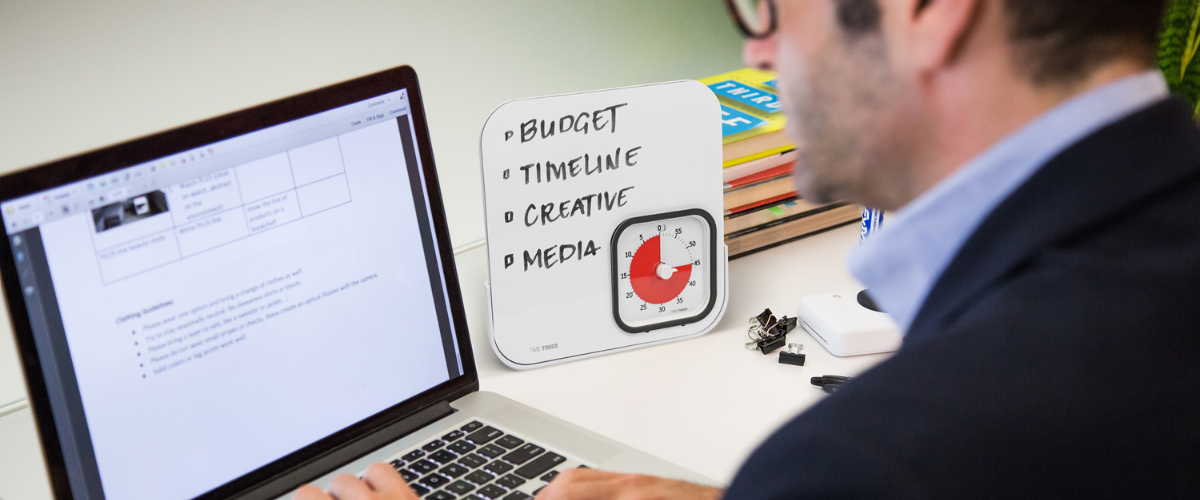Managing Type 1 diabetes requires a balance of timing, insulin, and blood-sugar management.
However, time limits can be difficult to follow just in your head. That's why visual timers can be great for people with diabetes, as these timers transform invisible deadlines into something concrete.
The Critical Timing Window
Injecting rapid-acting insulin to lower blood sugar levels often involves precise timing for when food will be consumed after.
For many diabetics, this timing window isn't negotiable, but rather is medically prescribed.
Parents of diabetic children may find this especially challenging, as the key is to do more than just make sure the children conform to the time plan, but to teach the children to form the habit themselves.
Why Visual Timers Help with Diabetes Management
The Time Timer visual timers' disappearing colored disk offers continuous feedback without the need to interpret numbers or mentally tally up elapsed time.
Specifically, our T1D toolkits are specifically made to help with meal-planning:
-
T1D Foundation Set: Time Timer MOD 30-Minute Timer and pages for insulin and carb tracking and meal and snack planning
-
T1D Expansion Set: Time Timer WASH + Soap Dispenser for hygiene routines, along with Time Timer Dry Erase Board that can fit the Time Timer MOD timer
-
The Final Piece: The Time Timer Watch is useful for mealtime planning on the go.
For children it can be a good alternative to parental reminders. That can help foster independence in children who need to learn to manage their condition on their own.
The silent countdown with an optional beep alarm at the end keeps things calm.
Creating Consistency and Useful Routines
Consistency is one of the pillars of diabetes management. Blood-sugar control depends on predictable patterns, including the following:
-
Meal timing
-
Carb counting
-
Insulin administration
-
Dependable food rituals
A visual timer becoming a regular presence at meals signals routine. For children, associating the elapsing disk with mealtime structure can provide comfort in having a helpful tool that contributes to their success.
Since visual timers are portable, these can help with keeping routines at school, restaurants, grandparents' houses, during travel, and more. This can help children learn to manage their condition independently even in new environments.
Uses Beyond Mealtime
This blog covered the primary use case of using visual timers for crucial post-insulin eating windows, but these timers can help with numerous other diabetes-related timing needs.
-
Managing Low-Blood-Sugar Episodes: Treating hypoglycemia with fast-acting carbohydrates usually requires waiting for a certain amount of time before rechecking blood-sugar levels. This can be a difficult wait, especially when there are uncomfortable symptoms. Setting a visual timer can be reassuring, keeping you on track to prevent over-treating the issue.
-
Insulin-Correction Timing: Rechecking after a correction dose for high blood sugar can result in stacking insulin doses, which can be dangerous. Using a timer during the appropriate waiting period can prevent stacking.
-
Pre-Meal Prep Time: Pre-bolusing, or taking insulin during a certain timeframe before eating, can be challenging, especially for children. Visual timers make it easier to understand this waiting period by making it feel manageable rather than frustrating.
-
Exercise and Blood-Sugar Monitoring: Some physical activities can raise blood sugar levels. Setting timers to check blood sugar during extended activities helps catch dangerous trends early. The visual countdown is particularly helpful during sports or outdoor play, and the Time Timer MAX visual timer is big enough to keep the countdown readily visible from a distance.
For Parents, Visual Timers Can Reduce Mealtime Power Struggles
Visual timers can shift the authority dynamic at mealtimes from parents to the neutral tool of a timer. Instead of parents repeatedly reminding children to eat, a neutral timer provides the information, parents can join their child in observing the countdown together.
The timer will have an authority of its own, and keeping one in the kitchen can be a good way of establishing the routine of pre-bolusing.
Children can also respond well to the timers' visual information that is easy to interpret, even for small children. Children with special needs can also easily interpret these timers. We even have a Braille timer!
Teaching Time Management in General
Beyond diabetes management, visual timers help children and adults alike develop better time awareness and self-regulation skills.
Consistently setting timers makes it easier to work on activities within time constraints. Not having to mentally keep track of time allows you to put more focus on the task at hand.
For children, timers can help them develop the ability to independently work within time constraints and understand the value of making the most of their time, which are valuable life skills.
For children with diabetes, they will eventually have to manage their condition independently. So, learning these time-management skills is more than just valuable from a life-skills perspective, but is tantamount for good health.
For parents, introducing visual timers can be like using training wheels for getting kids acclimated to the time management their condition demands.
Supporting Caregivers and Reducing Mental Load
Parents and caregivers of children with diabetes are calculating carbs, monitoring symptoms, tracking insulin doses, and, of course, keeping track of time.
Instead of internally tracking time, caregivers can make things easier on themselves by setting a visual timer to make diabetes management easier.
Make diabetes more manageable with Time Timer visual timers!





